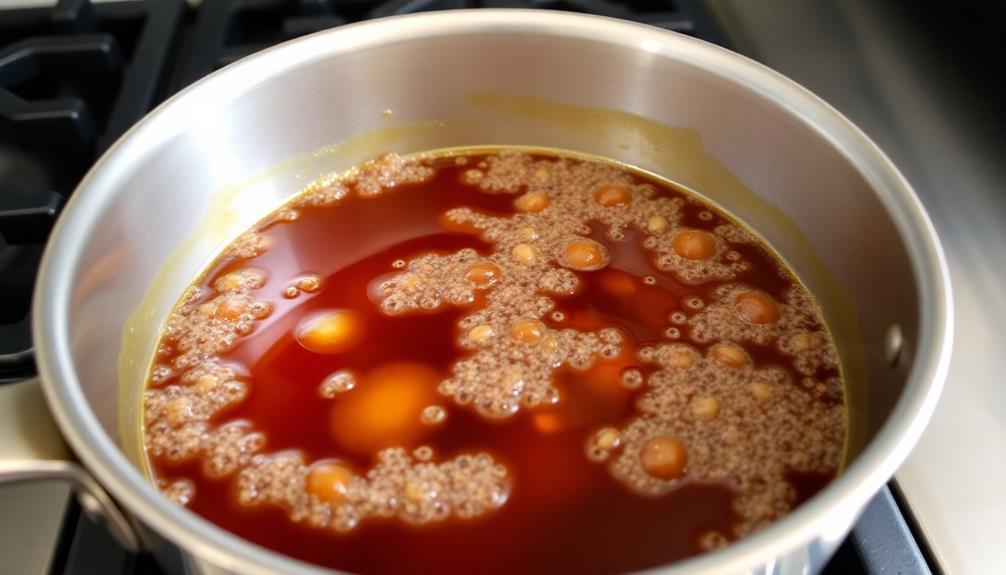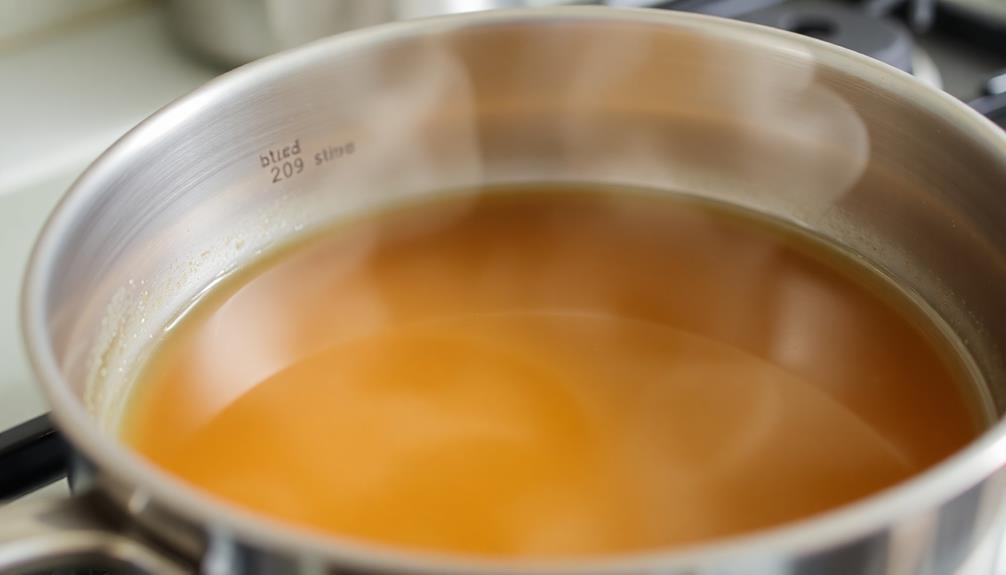Bring the delectable flavors of Japanese teriyaki to your kitchen with this DIY sauce recipe. Start with a base of soy sauce, mirin, brown sugar, and rice vinegar for the perfect balance of savory, sweet, and tart. Enhance the profile by stirring in sesame oil, minced garlic, and grated ginger. Simmer the mixture until it thickens, then adjust the seasonings to your taste. This versatile sauce can elevate all sorts of dishes, from marinating proteins to drizzling over stir-fries. With a few simple steps, you'll have a homemade teriyaki sauce that rivals any store-bought version. Keep reading to uncover even more tips for making this condiment a staple in your culinary repertoire.
Key Takeaways
- Prepare a homemade teriyaki sauce using a base of soy sauce, mirin, brown sugar, and rice vinegar for a balanced sweet and savory flavor.
- Enhance the sauce with aromatic ingredients like minced garlic and grated ginger to add depth and complexity.
- Simmer the sauce for 5-7 minutes until thickened, adjusting sweetness or saltiness to personal preference.
- Store the teriyaki sauce in an airtight container in the refrigerator for up to 1 week or freeze it for longer shelf life.
- Utilize the versatile teriyaki sauce for marinating proteins, glazing grilled vegetables, or adding flavor to various stir-fry dishes and rice/noodle meals.
History

Teriyaki sauce has a rich history that traces back to ancient Japan. The word "teriyaki" originates from the Japanese words "teri," meaning "luster," and "yaki," meaning "to broil" or "to grill." This cooking technique was first used by Japanese chefs to create a glossy, caramelized glaze on grilled meats and fish.
Over time, the teriyaki sauce recipe evolved, incorporating soy sauce, mirin, and sugar to achieve the signature sweet and savory flavor profile. As Japanese cuisine gained global popularity, teriyaki sauce became a beloved staple, finding its way into kitchens around the world.
Today, it's a versatile sauce used to marinate, baste, and add flavor to a wide range of dishes, from grilled meats to stir-fries and even vegetables.
Whether you're a seasoned cook or just starting to explore the world of homemade sauces, creating your own teriyaki sauce can be a rewarding and flavorful experience. With a few simple ingredients and a little culinary know-how, you can bring the rich history of teriyaki right to your own kitchen.
Recipe

Homemade teriyaki sauce is a versatile condiment that can elevate a variety of dishes. By making it yourself, you can customize the flavors to your liking and avoid the additives found in store-bought versions. This recipe yields a delicious, thick, and glossy sauce that's perfect for marinating, basting, or drizzling.
To begin, gather your ingredients and prepare your workstation. Teriyaki sauce is a simple blend of soy sauce, mirin, brown sugar, and a few additional flavorings, making it an easy and rewarding DIY project.
Ingredients:
- 1/2 cup soy sauce
- 1/4 cup mirin
- 2 tablespoons brown sugar
- 1 tablespoon rice vinegar
- 1 teaspoon sesame oil
- 1 garlic clove, minced
- 1 teaspoon grated fresh ginger
In a small saucepan, combine all the ingredients and whisk together over medium heat. Bring the mixture to a simmer, stirring occasionally, until the brown sugar has dissolved and the sauce has thickened slightly, about 5-7 minutes.
Be careful not to let the sauce boil vigorously, as this can cause it to reduce too quickly and become overly thick.
For best results, allow the sauce to cool slightly before using. The flavors will meld together as it cools, resulting in a well-balanced and flavorful teriyaki sauce.
This homemade version can be stored in an airtight container in the refrigerator for up to 1 week, making it a convenient and versatile condiment to have on hand.
Cooking Steps

To make the teriyaki sauce, start by combining all the ingredients in a saucepan.
Bring the mixture to a simmer and let it cook until it's thickened to your desired consistency.
Once the sauce has cooled slightly, transfer it to a jar for easy storage and use.
Step 1. Combine All Ingredients in Saucepan

Now, grab a medium-sized saucepan and add all the ingredients.
First, pour in the soy sauce, rice vinegar, brown sugar, minced garlic, and grated ginger. Stir them together until the sugar has fully dissolved.
Next, sprinkle in the cornstarch and whisk vigorously to prevent any lumps from forming.
Once everything is well combined, place the saucepan over medium heat on your stovetop.
Bring the mixture to a gentle simmer, stirring occasionally, and let it cook for about 5 minutes.
You'll notice the sauce thickening up as it heats through.
Step 2. Bring to a Simmer

Once the ingredients are well combined, place the saucepan over medium heat on your stovetop.
Bring the mixture to a gentle simmer, stirring occasionally. You'll notice the sauce slowly coming together, the flavors melding into a delicious teriyaki blend.
Keep a close eye on the pot, adjusting the heat as needed to maintain that gentle simmer. You don't want the sauce to boil or it may become too thick and concentrated.
Simmer for about 5-7 minutes, stirring frequently, until the sauce has thickened to your desired consistency.
Feel free to give it a taste at this point. If it needs a touch more sweetness or saltiness, now's the time to make any final adjustments.
Just be careful not to overpower the other flavors. The goal is a balanced, harmonious teriyaki sauce.
Once it's reached the perfect thickness, remove the saucepan from the heat and let the sauce cool slightly before serving or bottling.
Step 3. Simmer Until Thickened

With the ingredients well combined, place the saucepan over medium heat on your stovetop. Bring the mixture to a simmer, stirring occasionally.
Once simmering, reduce the heat to low and let the sauce thicken, continuing to stir intermittently. This process should take about 10-15 minutes. Keep a close eye on the pan, as you don't want the sauce to boil and become too reduced.
As the sauce thickens, it will become glossy and coat the back of a spoon. When it reaches your desired consistency, remove the pan from the heat.
Taste the sauce and adjust any seasonings as needed, perhaps adding a touch more soy sauce or brown sugar. The finished teriyaki sauce should be thick, rich, and bursting with umami flavor.
Drizzle it over your favorite grilled or roasted meats, vegetables, or rice dishes. Enjoy your homemade teriyaki creation!
Step 4. Let Sauce Cool Slightly

After removing the saucepan from the heat, let the teriyaki sauce cool down slightly, about 2-3 minutes. This will give the sauce a chance to thicken up even more as it sits.
You don't want to pour the sauce onto your dish right away, as it'll be extremely hot and could potentially burn your tongue. Instead, take this brief time to prepare your meal components, such as steaming some rice or chopping up fresh veggies.
Once the sauce has cooled a bit, give it a quick stir. You'll notice it's reached a nice, glossy consistency – perfect for drizzling over your stir-fry, grilled meats, or rice bowls.
Be careful, though, as the sauce will still be quite warm. Use a spoon to gently drizzle the teriyaki sauce over your meal, allowing it to evenly coat everything. The flavor will be bright, savory, and utterly delicious. Enjoy your homemade teriyaki creation!
Step 5. Transfer to Jar

Are you ready to transfer the teriyaki sauce to a jar? Once the sauce has cooled slightly, it's time to pour it into a clean, airtight jar or container. This will allow you to store the sauce for later use.
Grab a funnel, if you have one, to make the process easier and minimize any mess. Slowly pour the teriyaki sauce into the jar, being careful not to spill. Fill the jar, leaving a bit of headspace at the top. This extra space will help prevent the sauce from expanding and potentially leaking if it gets cold.
Once the sauce is in the jar, secure the lid tightly. This will help the sauce stay fresh and prevent any air from getting in.
You can now store the teriyaki sauce in the refrigerator for up to two weeks. When you're ready to use it, simply take the jar out and enjoy your homemade teriyaki sauce on your favorite dishes.
Final Thoughts

Ultimately, homemade teriyaki sauce is an incredibly versatile condiment that can elevate a wide range of dishes.
Whether you're marinating proteins, drizzling it over stir-fries, or using it as a dipping sauce, this DIY recipe provides endless possibilities. The best part? You can customize the flavors to your taste, adjusting the sweetness, saltiness, or even adding a kick of heat.
Once you've perfected your teriyaki sauce, you'll find yourself reaching for it time and time again.
It's a fantastic way to add depth and complexity to your cooking, transforming simple ingredients into something truly mouthwatering.
So don't be afraid to experiment and get creative – the possibilities are endless when you have this flavorful sauce in your culinary arsenal.
Enjoy your homemade teriyaki sauce, and let your taste buds be the guide on your culinary adventures.
Frequently Asked Questions
How Long Can Homemade Teriyaki Sauce Be Stored?
Homemade teriyaki sauce can be stored for up to a week in the refrigerator. Make sure to keep it in an airtight container, and it'll maintain its flavor and consistency. Enjoy your delicious homemade sauce!
Can I Use a Different Type of Soy Sauce?
Yes, you can use a different type of soy sauce in your homemade teriyaki sauce. Just keep in mind that the taste may vary depending on the type of soy sauce you choose.
Is It Necessary to Use Mirin in the Recipe?
The use of mirin in the recipe is not strictly necessary, but it does provide a distinct flavor and texture that can enhance the overall taste. You can experiment with substitutes like rice vinegar or honey if you don't have mirin on hand.
Can I Substitute the Brown Sugar With Another Sweetener?
You can substitute the brown sugar with another sweetener, such as honey, maple syrup, or even agave nectar. The key is to adjust the amount to achieve your desired level of sweetness in the recipe.
How Can I Adjust the Sauce's Thickness and Consistency?
To adjust the sauce's thickness and consistency, you can try reducing it further on the stovetop or adding a bit of cornstarch or arrowroot powder. This will help thicken the sauce to your desired texture.










